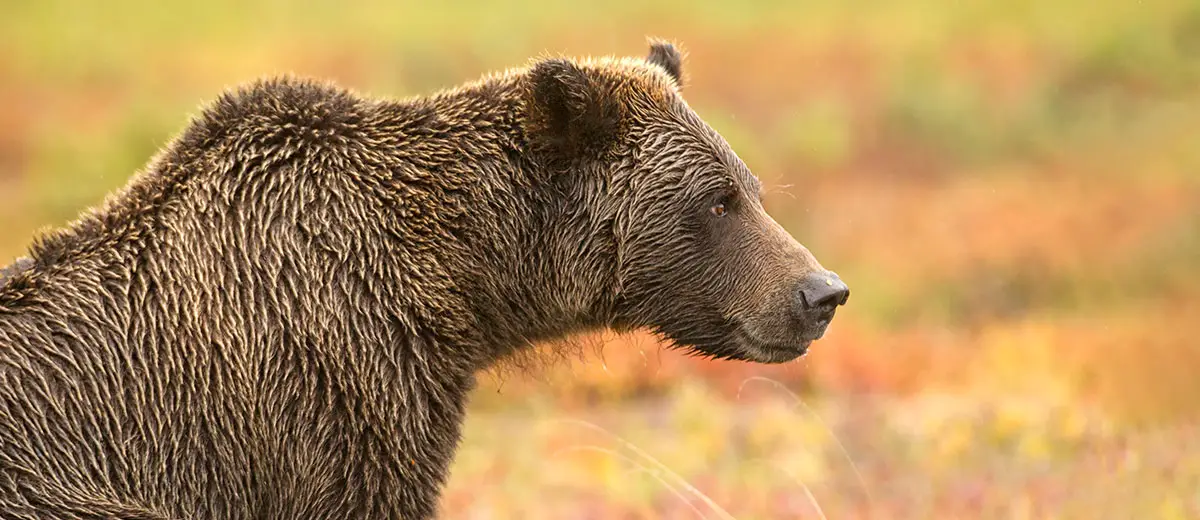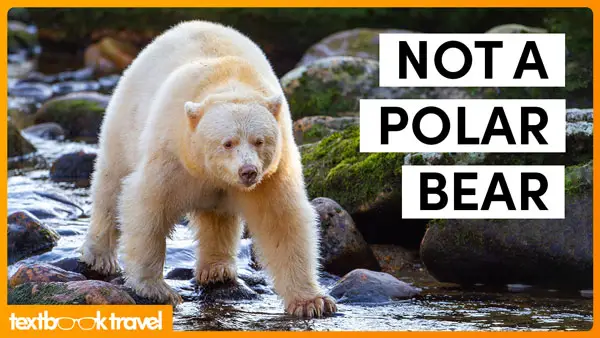All 8 Species of Bear (+7 Most Beautiful Subspecies)
Bears are magical, powerful creatures that exist on 4 of the 7 continents: South America, North America, Europe and Asia. They range in size and distribution from the gigantic polar bears of the arctic to the tiny sun bears of Southeast Asia. In this guide, we’ll discuss all 8 species of bear, where they live and discover 7 beautiful subspecies covering a wide range of colour morphs including the Tibetan blue bear and the entirely white spirit bear. Let’s dive in!
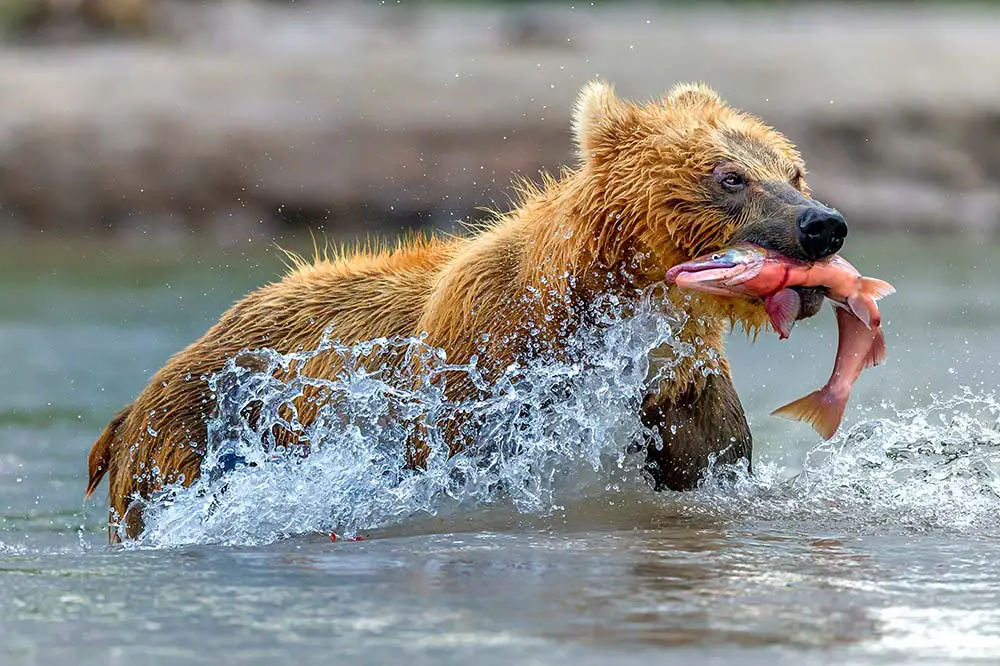
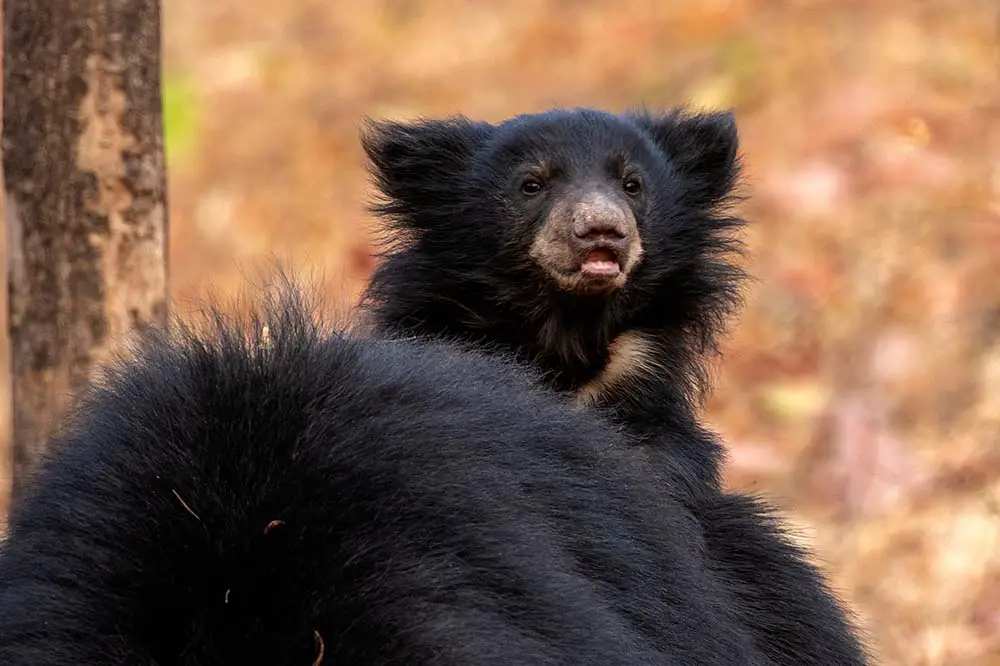
Left: Brown bear eating salmon in Kamchatka, Russia | Giuseppe D’Amico / Shutterstock & Right: Sloth bear and cub riding on her back Alan De Witt / Shutterstock
Contents
- Giant panda | Ailuropoda melanoleuca
- Qinling panda | Ailuropoda melanoleuca qinlingensis
- Spectacled bear | Tremarctos ornatus
- Sloth bear | Melursus ursinus
- Sun bear | Helarctos malayanus
- Asiatic black bear | Ursus thibetanus
- American black bear | Ursus americanus
- Cinnamon bear | Ursus americanus cinnamomum
- Kermode (Spirit) bear | Ursus americanus kermodei
- Brown bear | Ursus arctos
- Kamchatka brown bear | Ursus arctos beringianus
- Himalayan brown bear | Ursus arctos isabellinus
- Syrian brown bear | Ursus arctos syriacus
- Tibetan blue bear | Ursus arctos pruinosus
- Polar bear | Ursus maritimus
01 – Giant Panda | Ailuropoda melanoleuca
Taxonomically, Giant Pandas are the most distant species from all other bears. They are easily distinguished by their round faces, black and white coat, and stocky build, weighing up to 275 lbs (125kg). Almost all of a panda’s diet is made up of bamboo, which is a poor nutritional source but easily accessible in the forests they inhabit. They will eat for up to 16 hours per day and are well-known to do so in an upright position. This species once roamed much of central and southeastern China, Myanmar and northern Vietnam but is now found solely in a small collection of mountainous bamboo forests in central China. Pandas are solitary by nature and have a relatively small range of up to 6 square kilometres (2.3 square miles), which they maintain by rubbing their scent gland against trees. The conservation status of the giant panda is currently set to vulnerable, although they are protected and highly revered in China, with their government even building bamboo corridors to allow them to move freely between mountain ranges.
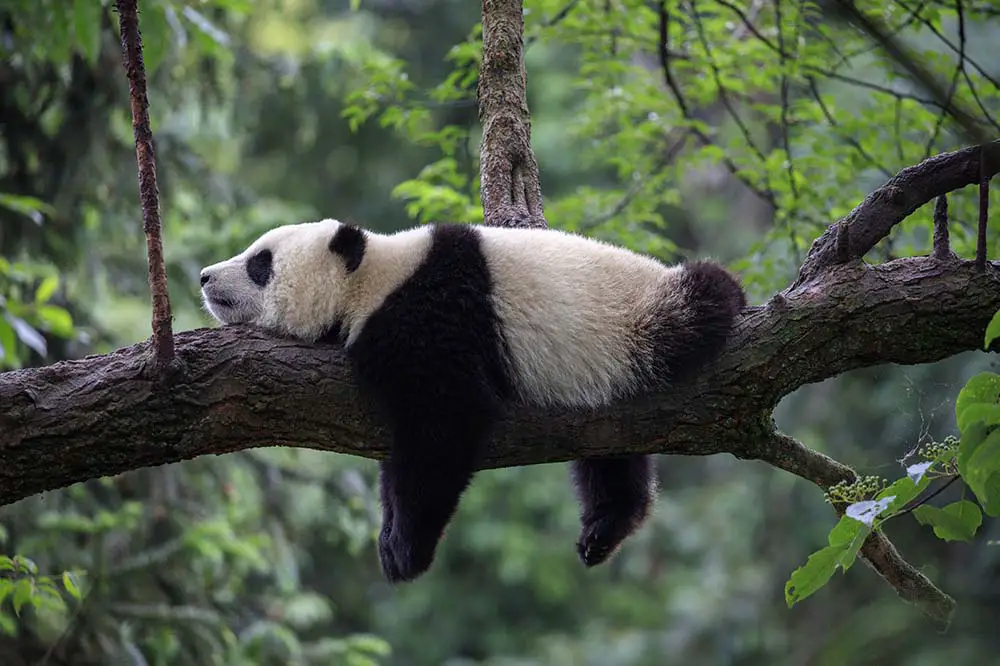
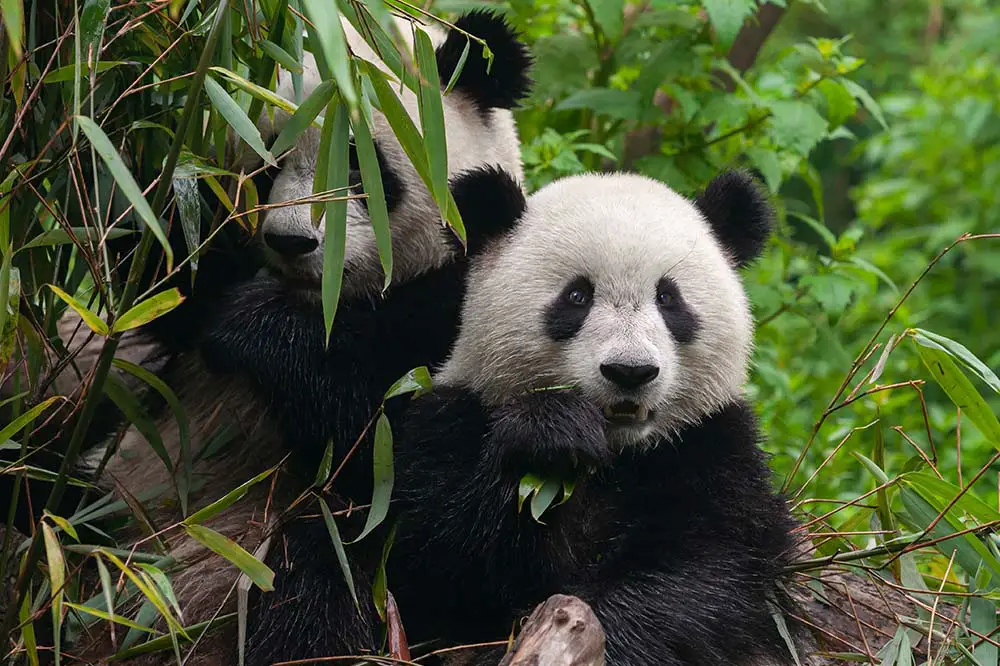
Left: Panda bear sleeping on a tree branch | clkraus / Shutterstock & Right: Panda bears eating bamboo | Hung Chung Chih / Shutterstock
02 – Qinling panda | Ailuropoda melanoleuca qinlingensis
The Qinling panda wasn’t officially recognised as a subspecies until 2005 and besides the nominate subspecies that we’ve discussed, is the only recognised subspecies. They are named after the Qinling mountain range where they live and are extremely rare with estimates ranging from 100 to 300 remaining in the wild. Qinling pandas have a beautiful brown coat, are slightly smaller, and exhibit the exact behavioural traits of regular pandas.
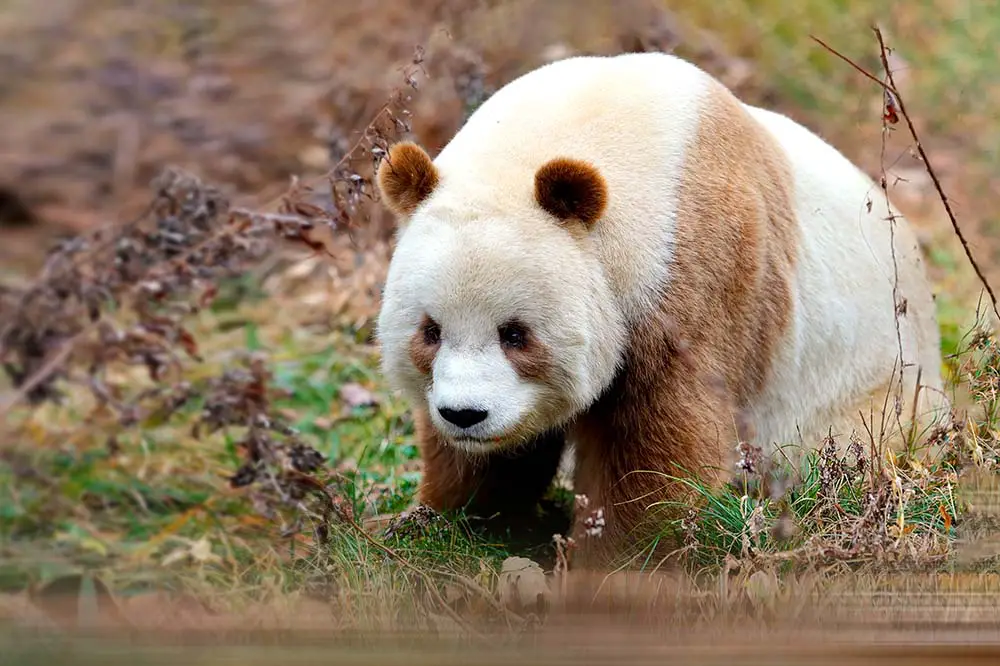
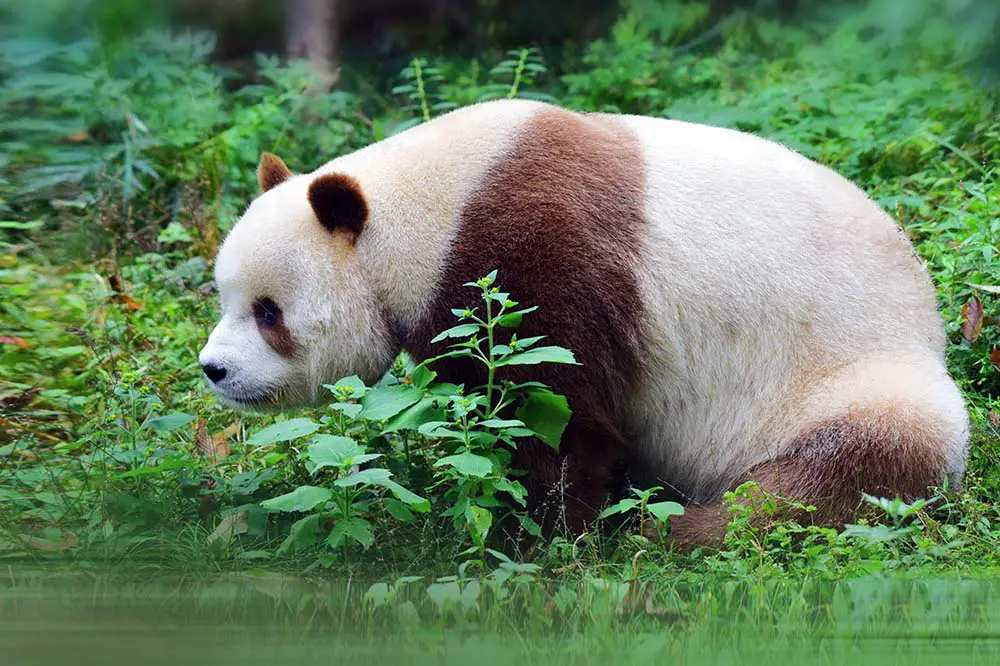
Left & Right: Qinling pandas | Wang LiQiang / Shutterstock
03 – Spectacled Bear | Tremarctos ornatus
The spectacled bear is named as such due to the black markings around their eyes encircled in white, although this pattern is not clearly defined on all individuals. Spectacled bears are found in the mountain ranges of South America, particularly the Andes, where they are the only species of bear on the continent. They are generally found in cloud forests, which are tropical forest ecosystems found at higher elevations and covered in cloud for most of the year. A medium-sized bear, weighing up to around 440lbs (200kg), they are known as excellent climbers and are often found relaxing at the tops of trees. Like the panda, the spectacled bear is a species of bear that does not hibernate due to an abundance of food year-round. Perhaps the most well-known spectacled bear is Paddington, who, being sent by his aunt Lucie, arrived in London as a stowaway from “Darkest Peru”.
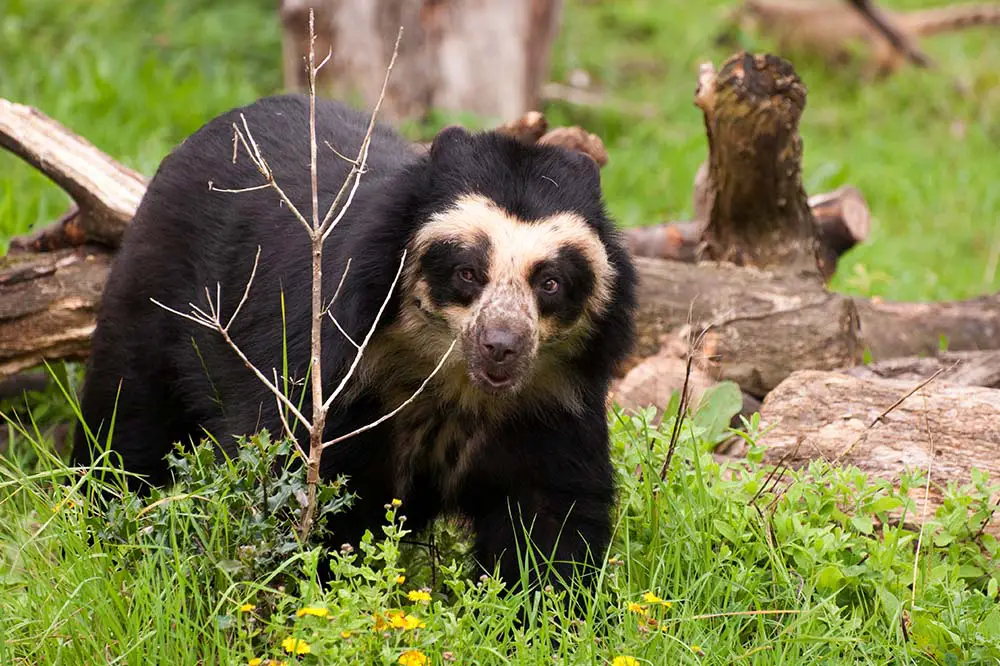
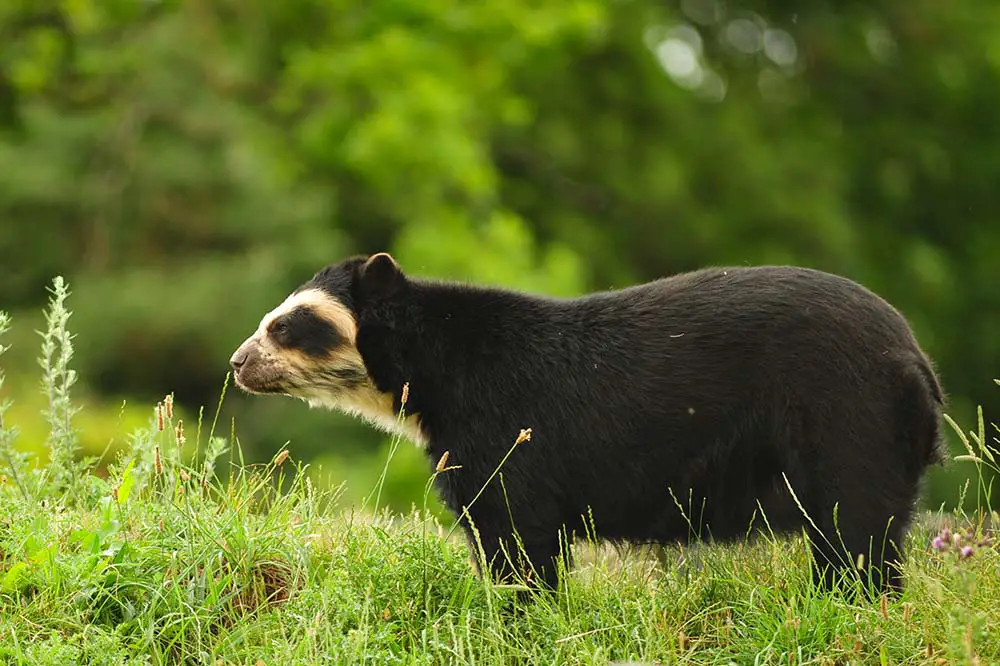
Left: Spectacle bear face with black eye patches | Chris Humphries / Shutterstock & Right: Spectacled bear side profile | Lighttraveler / Shutterstock
04 – Sloth Bear | Melursus ursinus
Sloth bears are a slow-moving species who have poor eyesight and hearing but have a keen sense of smell used to detect termites and ants, which they suck up through their elongated snouts—a sound that can be heard from almost 200 meters away. They are found in the tropical forest and grassland areas of southern Asia with the majority of their population residing in India. Sloth bears have long, shaggy fur and a white V-shaped mark on their chest, which is sometimes absent, especially in Sri Lanka. They breed in the early spring and, after a gestation period of around 210 days, usually give birth in the winter. Cubs ride on their mothers’ backs until they are large enough to fend for themselves and become fully independent after 24-36 months. As with the panda and the spectacled bear, the sloth bear’s conservation status is currently listed as vulnerable.
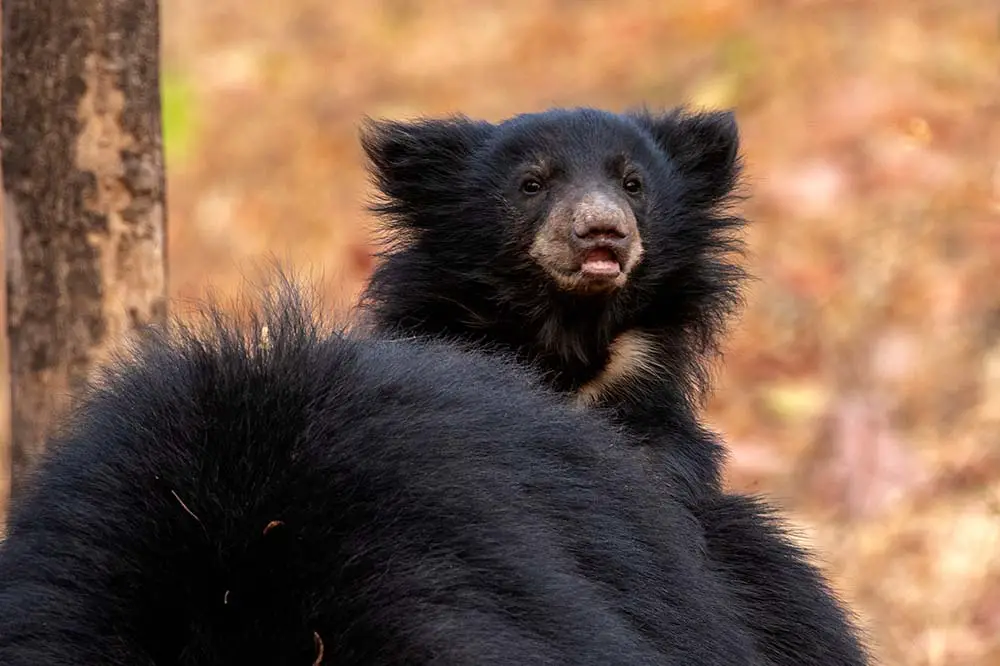
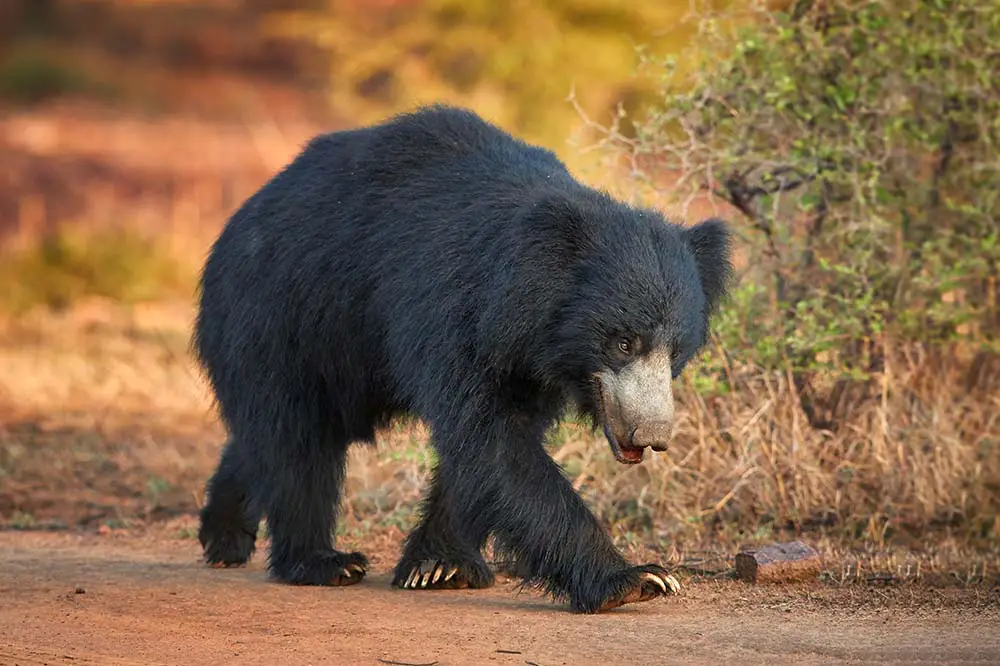
Left: Sloth bear and cub riding on her back | Alan De Witt / Shutterstock I & Right: Sloth bear in Ranthambore | Martin Mecnarowski / Shutterstock
05 – Sun Bear | Helarctos malayanus
The sun bear is the smallest of all bear species, with even the largest individuals weighing no more than 140lbs (63kg) and standing around 70cm at the shoulder. Like the sloth bear, sun bears also hunt termites along with bees and earthworms and have exceptionally long tongues for doing so. They are excellent climbers and are thought to be the most arboreal of all bears, usually sleeping several meters off the ground. They are found throughout much of South and Southeast Asia, as far north as India and as far south as the islands of Borneo and Sumatra. Living mainly in the tropical forest biome where food is available all year round, they are another species of bear that do not hibernate. Sun bears are thought to be the rarest of all bear species with some research estimating there could be less than 1,000 left in the wild.
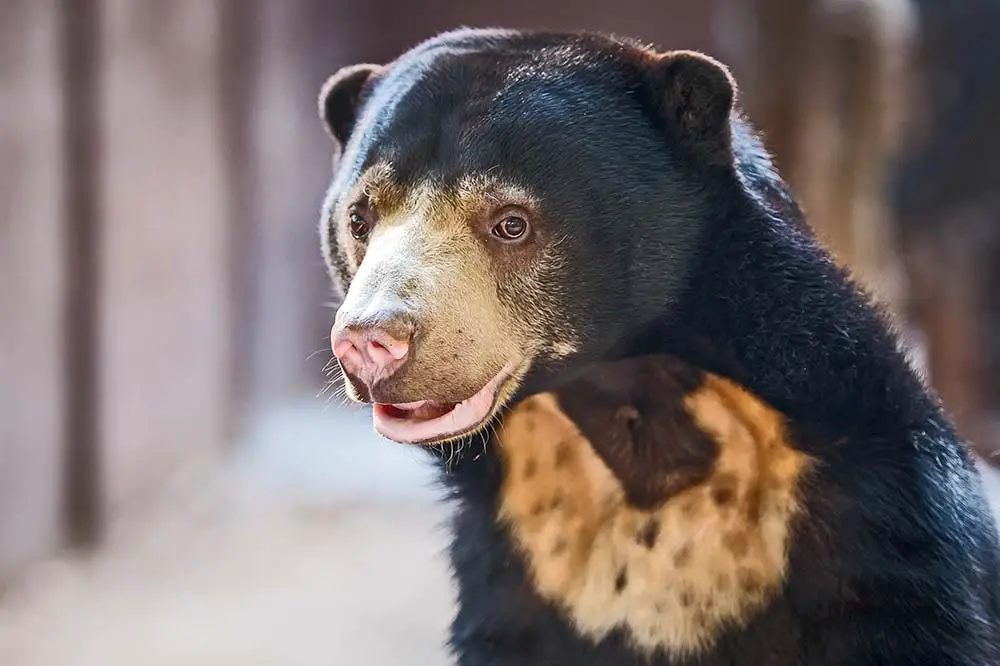
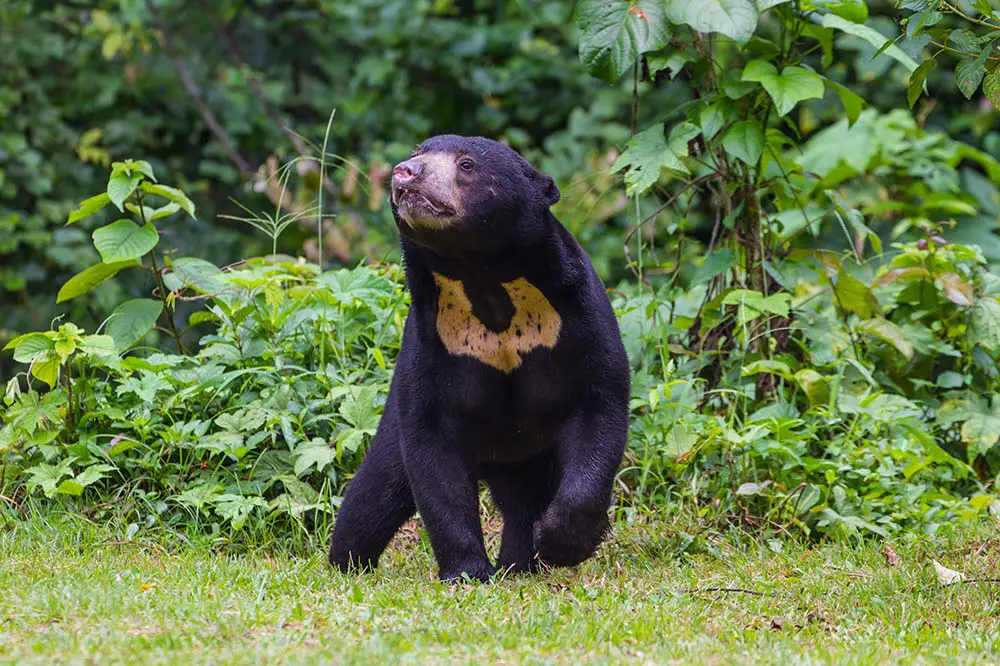
Left: Malayan sun bear profile | TigerStocks / Shutterstock & Right: Malayan sun bear with white mark on chest | forest71 / Shutterstock
06 – Asiatic Black Bear | Ursus thibetanus
The Asiatic black bear is the first bear we’ll look at in the Ursus genus, which contains all remaining bears on this list. They are similar in appearance to the American black bear, which we’ll discuss next, but have longer hair around the neck and, similar to that of the sloth bear, have a white moon-shaped mark on their chest. Due to this pattern, this species is also known as the moon bear or the white-chested bear. Asiatic black bears have a large range, being found as far west as Iran, through the Himalayas, and into east and southeast Asia where they roam as far north as Siberia and as far south as southern Thailand. They are exceptional climbers and will often use their arboreal environment to eat, rest and escape larger carnivores such as leopards, tigers, brown bears and packs of wolves. Members of this species who live in the northern parts of their range will spend the winter in dens where they become dormant—a state of reduced metabolic activity that allows them to survive off their fat stores until spring.
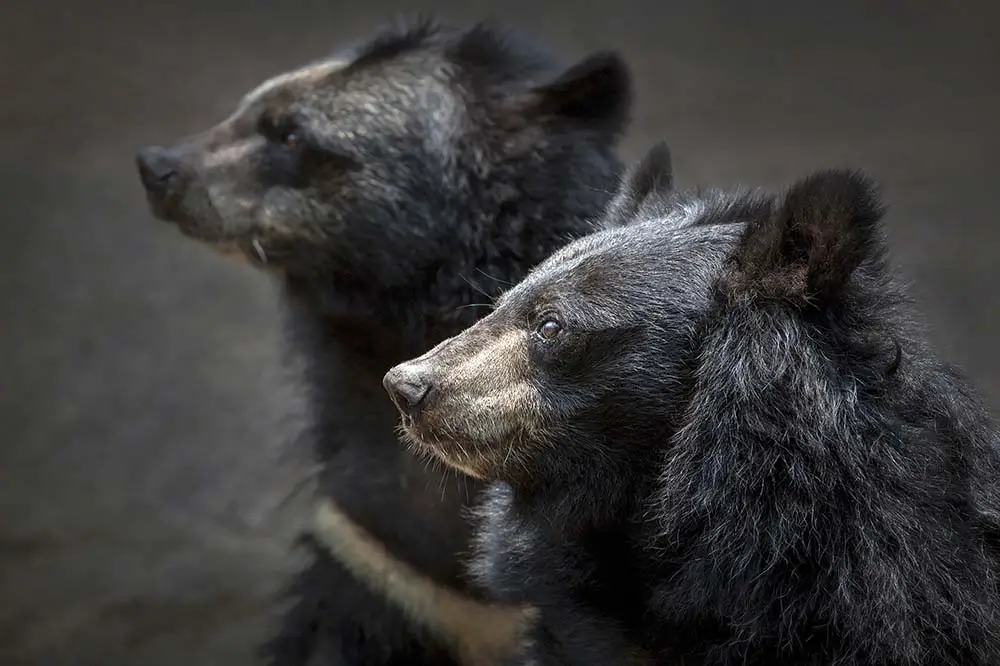
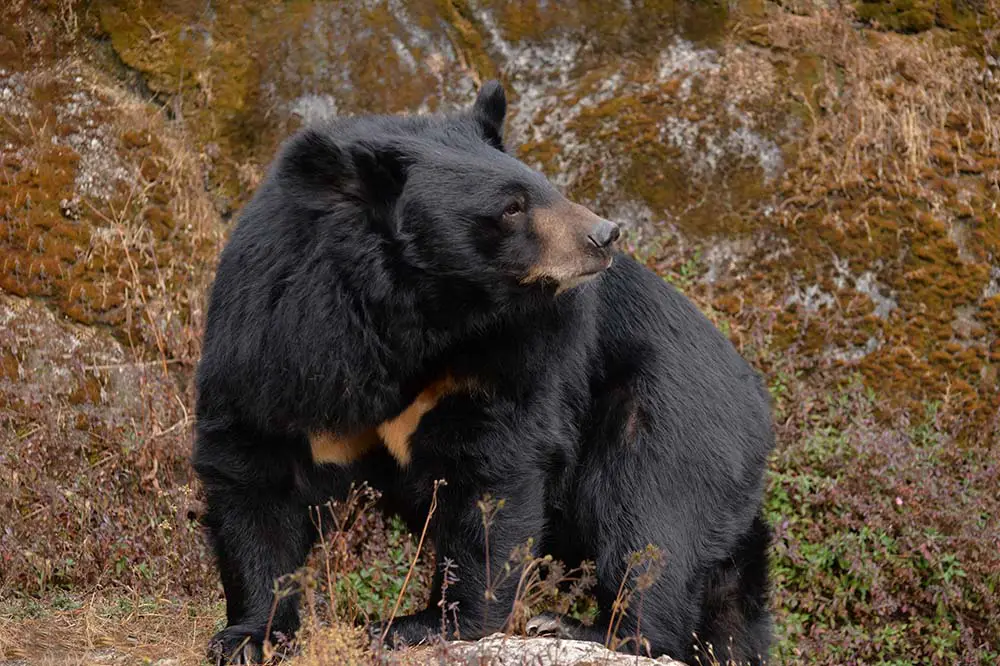
Left: Pair of Asiatic black bears | jeep2499 / Shutterstock & Right: Himalayan black bear | Shayak_rc / Shutterstock
07 – American Black Bear | Ursus americanus
The American black bear is the first species we’ll discuss with a conservation status of least concern. In terms of size, they rank third behind brown and polar bears, weighing up to around 600lbs (272kg). The American black bear has a large range from Alaska and Newfoundland in the far north, to parts of Mexico and Florida in the south. The colour variation and distribution of those variations are fascinating. In the east, black bears are just that, black. However, it has been reported that areas further west can see over 90 percent of black bears exhibiting a brown or blonde coat. They can also be found with a silver-blue coat in Alaska, a subspecies named the glacier bear which is exceptionally rare. They are omnivorous, eating large quantities of fruit and nuts, but will also hunt large mammals such as moose calves and deer fawns. Fun fact, bears are not technically true hibernators because their body temperature does not drop during their dormancy. Regardless, the American black bear will also survive the winter in a den and can emerge in spring 15-30% lighter.
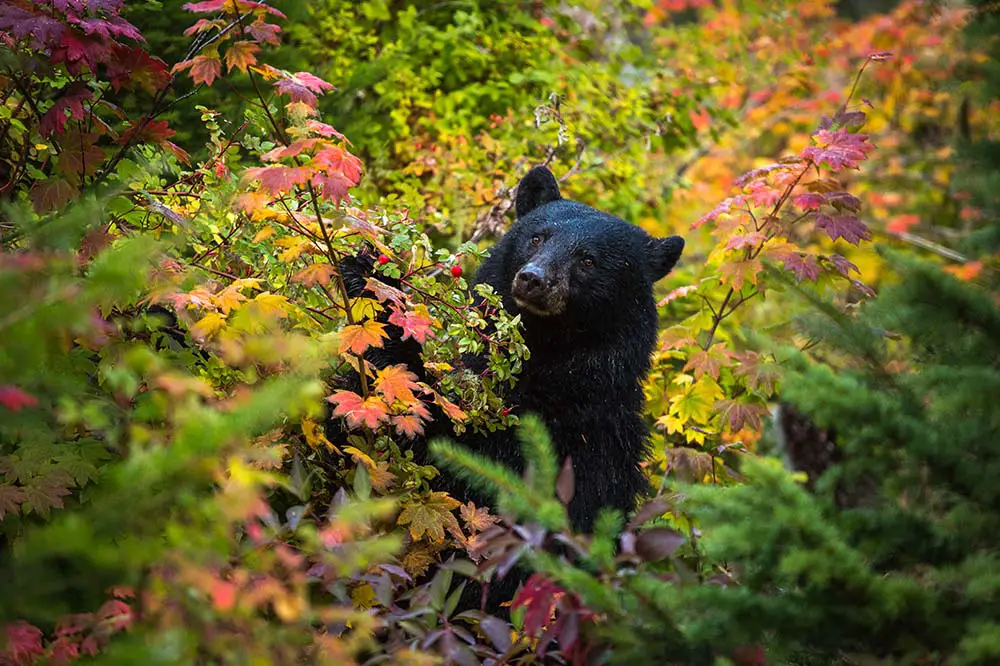
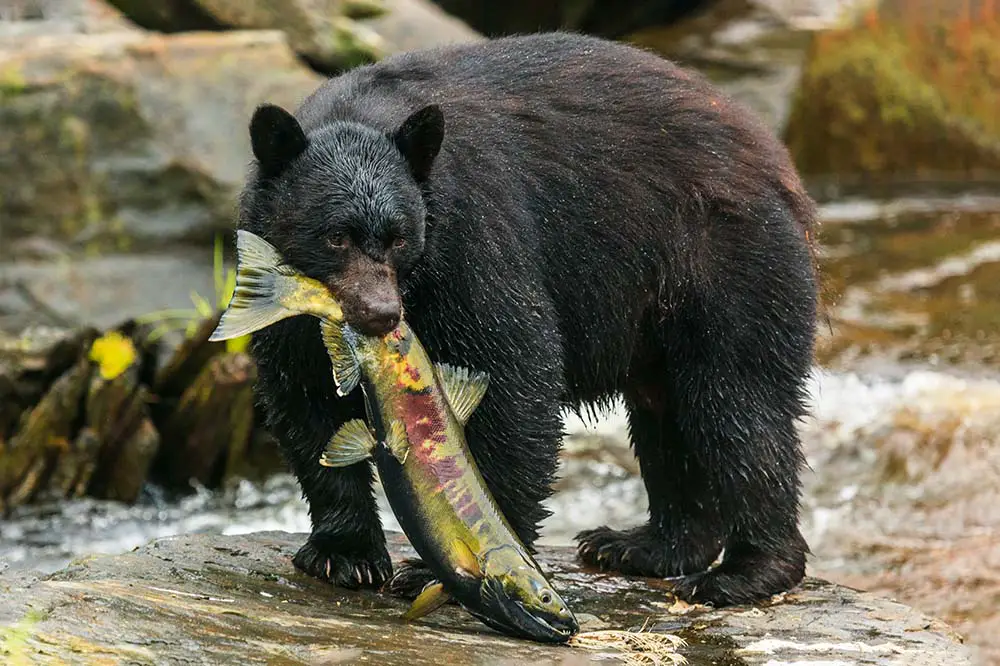
Left: Black bear adult eating berries | Brad Doerksen / Shutterstock & Right: Black bear salmon fishing | emperorcosar / Shutterstock
08 – Cinnamon bear | Ursus americanus cinnamomum
The cinnamon bear is the first of two black bear subspecies that we’ll look at with a particularly unique appearance. They are often mistaken for grizzly bears thanks to their light, cinnamon-coloured coat, which some researchers suggest is not a coincidence. It is thought that through the evolutionary process of natural selection, cinnamon bears have come to mimic the colour of grizzlies, a larger and more aggressive species, to ward off the likes of wolves and other pesky carnivores. It is also suggested that the eastern brown-coloured bears use their coat for camouflage, ironically to hide from grizzly bears who are not found on the east coast.
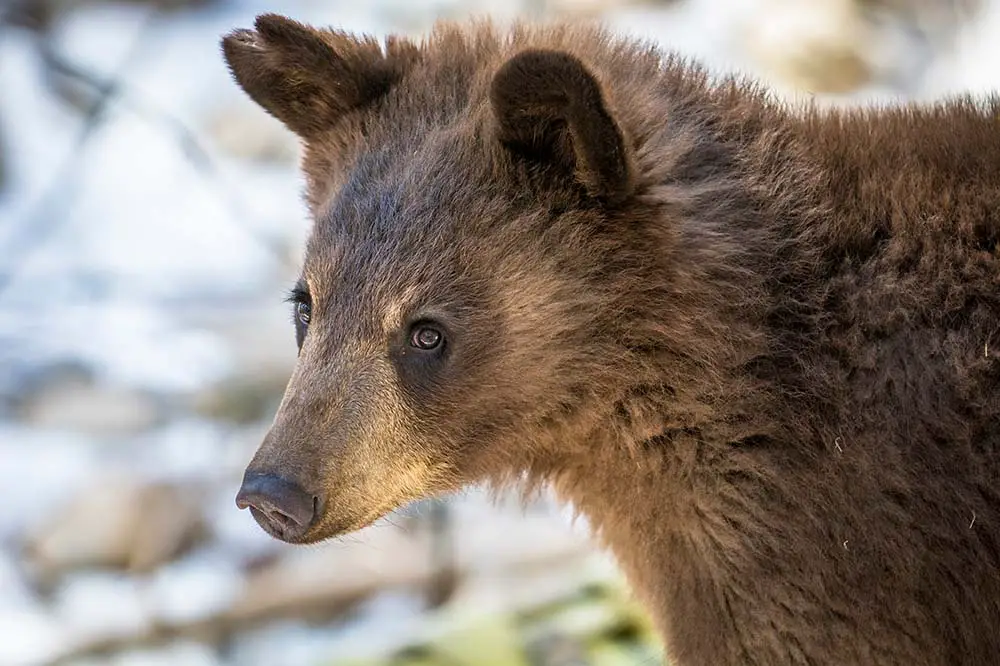
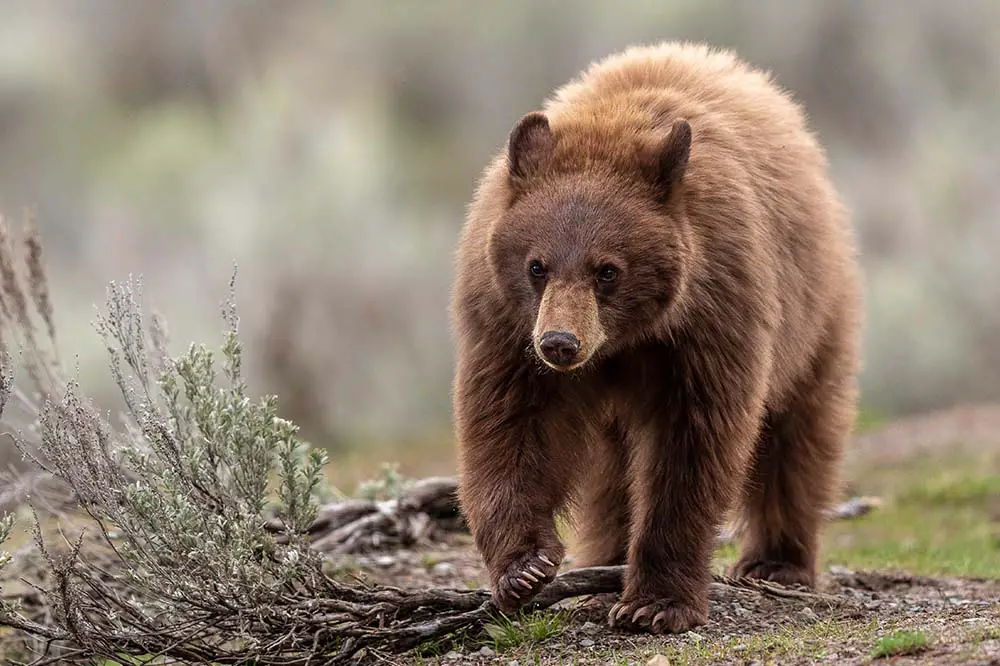
Left: Cinnamon black bear cub at Adirondack Wildlife Refuge, Upstate New York | James Casil / Shutterstock & Right: Cinnamon-coloured black bear cub | Greg Westbrook / Shutterstock
09 – Kermode (Spirit) bear | Ursus americanus kermodei
The Kermode bear is a magical subspecies of black bear found in the coastal forests of British Columbia where it is the provinces’ official animal and is highly revered by the indigenous population. Due to the colour of their coat, these bears are often assumed to be a black bear in albino form but this light colouration is in fact caused by the lack of a particular gene, preventing the production of melanin and producing an entirely white bear known as the spirit bear. Not every member of this subspecies lacks this gene, meaning that there are both black and white Kermode bears. It is estimated that there are between 100-500 spirit bears, which can make up to 10-20% of the population in some areas.
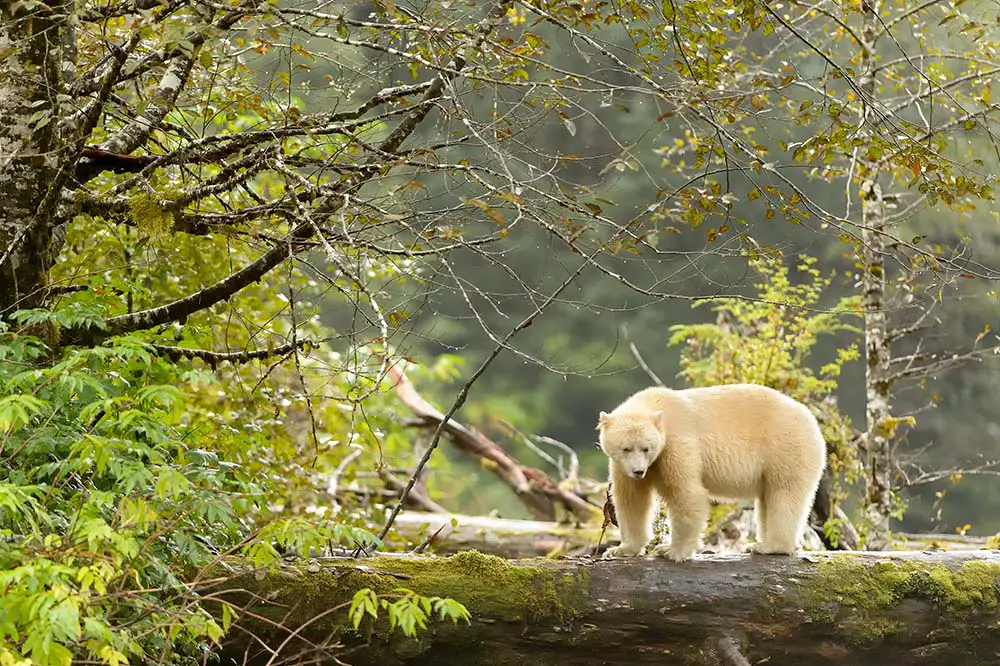
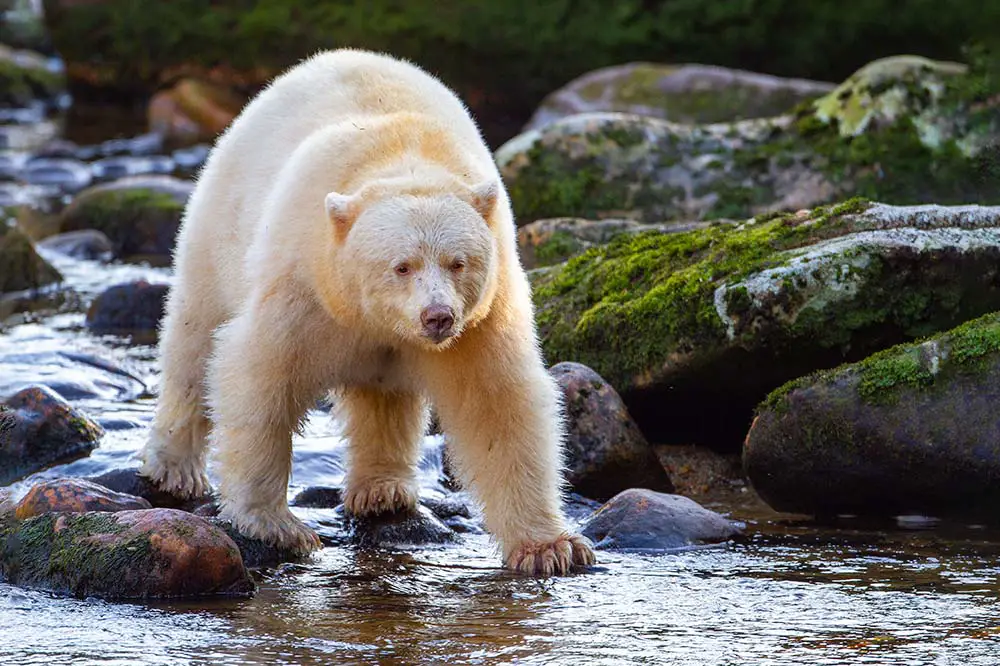
Left: Spirit bear adult | NaturesMomentsuk / Shutterstock & Right: Spirit bear searching for salmon in BC, Canada | Lynn A / Shutterstock
10 – Brown Bear | Ursus arctos
The brown bear, which is also known as the grizzly bear in North America is second only in size to the polar bear with the largest individuals on Alaska’s Kodiak island weighing up to 1,500 lbs (680kg) in the most extreme cases. They have a large range spanning much of the northern hemisphere from small populations in Europe to the Middle East, the Himalayas and Russia through to Alaska, Canada and northern parts of the contiguous United States. There are currently 17 defined subspecies, which display some spectacular colour morphs. Although they can be similar in appearance to larger brown-coloured black bears, brown bears have a large hump of muscle at the top of their shoulder, a testament to how powerful these animals are. Brown bears mate around May or June and females will give birth during the winter, usually while they are still hibernating, emerging in spring with their cubs, which are usually 2-3 in number.
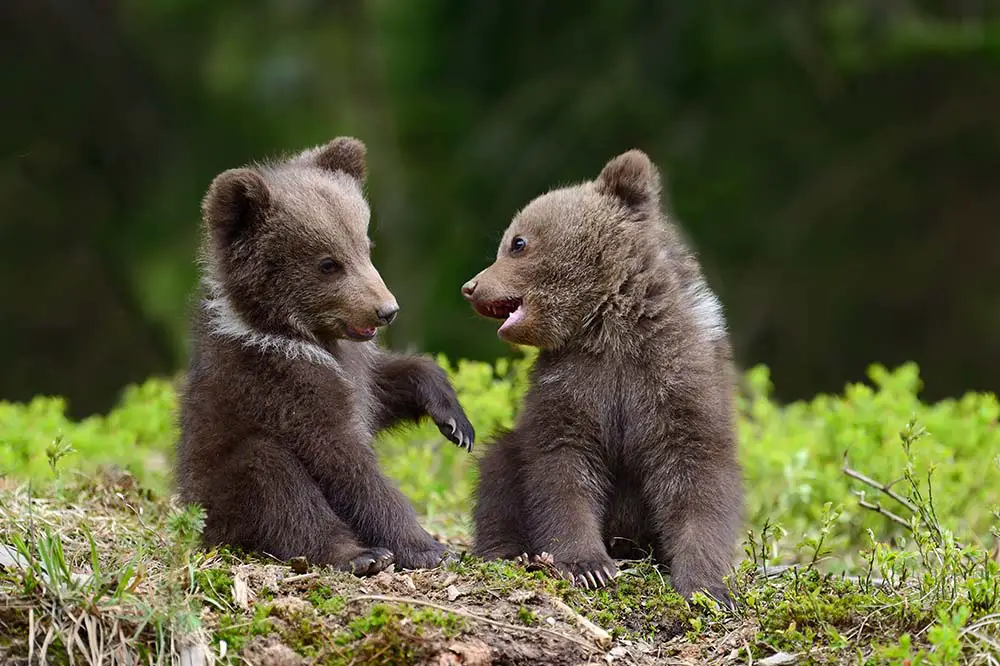
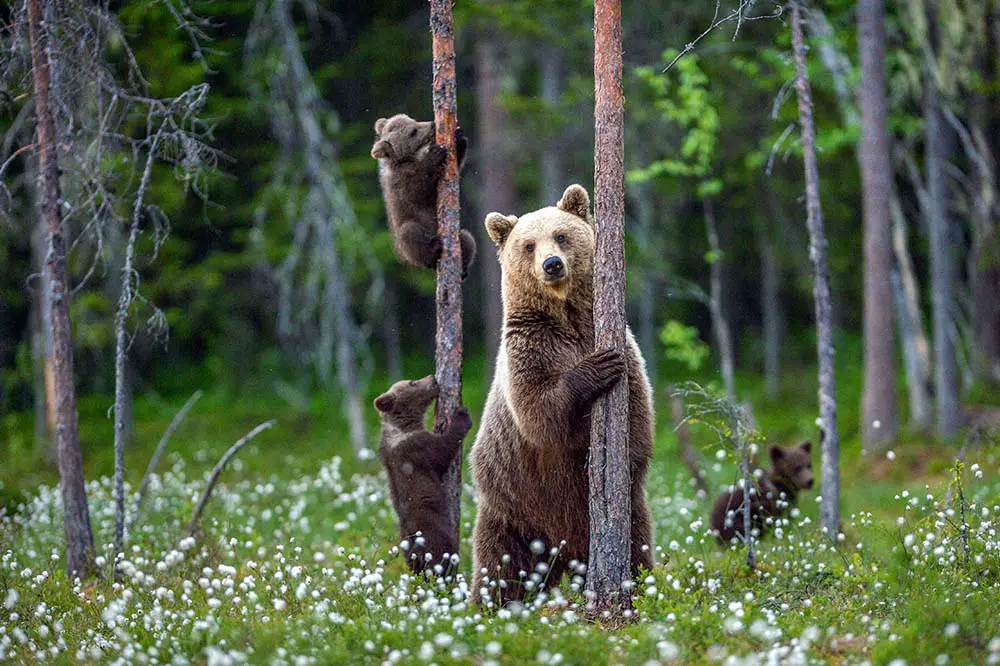
Left: Brown bear cubs | Volodymyr Burdiak / Shutterstock & Right: Momma bear and bear cubs in the summer forest | Sergey Uryadnikov / Shutterstock
11 – Kamchatka brown bear | Ursus arctos beringianus
The Kamchatka brown bear is a particularly large and beautiful subspecies that often exhibit a dark brown coat. They are found on the volcanic Kamchatka peninsula in far eastern Russia, which, largely thanks to its isolation, is home to the largest density of brown bears in the world. Their home range can vary greatly depending on the amount of food, with some individuals roaming 1100 square kilometres (683sq miles) in search of food. This mountainous peninsula is home to one of the highest populations of salmon in the world, which, when it’s not illegally poached by humans, provides the bears here with a reliable source of meat, hence their size. Kamchatka brown bears can reach almost the same size as Alaska’s Kodiak bear with males weighing almost 1500lbs (680 kg).
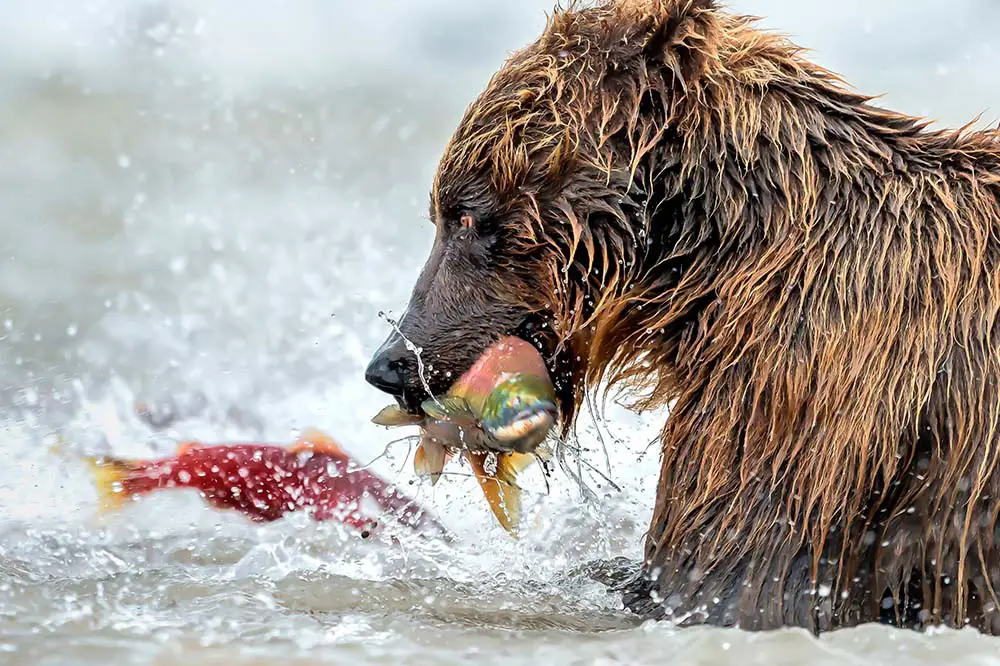
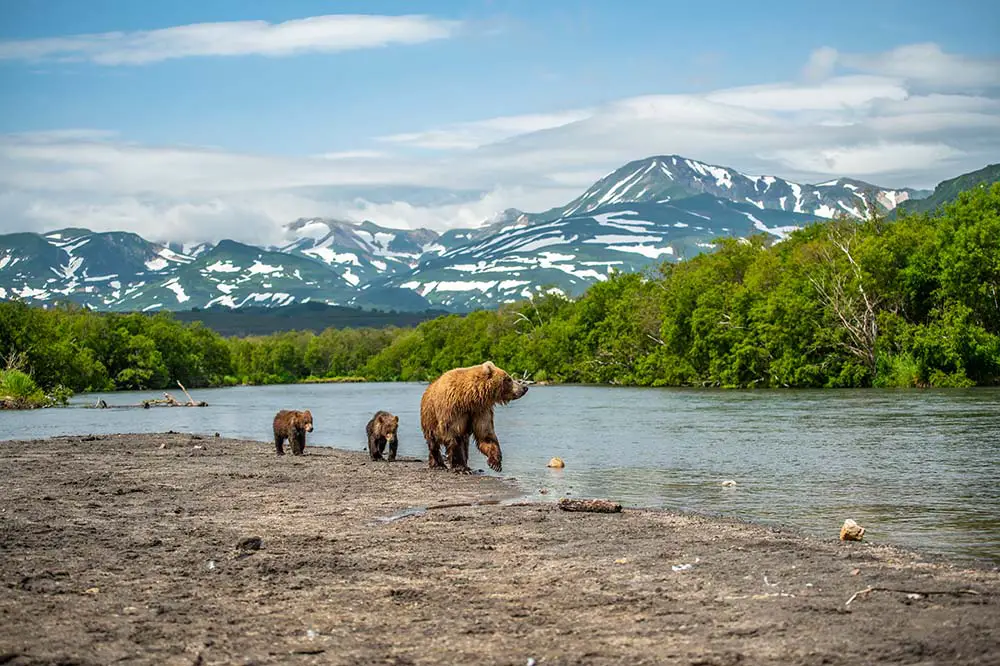
Left: Bear fishing for salmon at Kurile Lake, Kamchatka, Russia | Giuseppe D’Amico / Shutterstock & Right: Brown bears of Kamchatka roaming the landscape | Vaclav Sebek / Shutterstock
12 – Himalayan brown bear | Ursus arctos isabellinus
The Himalayan brown bear is an endangered subspecies of brown bear also known as the Himalayan red bear. They are much lighter in colour and exhibit a longer pelage that helps keep them warm in their chilly environment. As their name would suggest, this subspecies is found in the areas surrounding the Himalayan mountain range in Central Asia where they trek across the snowy slopes in search of food. Like almost all species of bear, these brown bears are omnivores, stocking up on grasses, roots and other vegetation in addition to other mammals such as goats and sheep before entering hibernation around October. Although brown bears are not endangered, the Himalayan brown bear is highly endangered and protected in several of the countries where it exists.
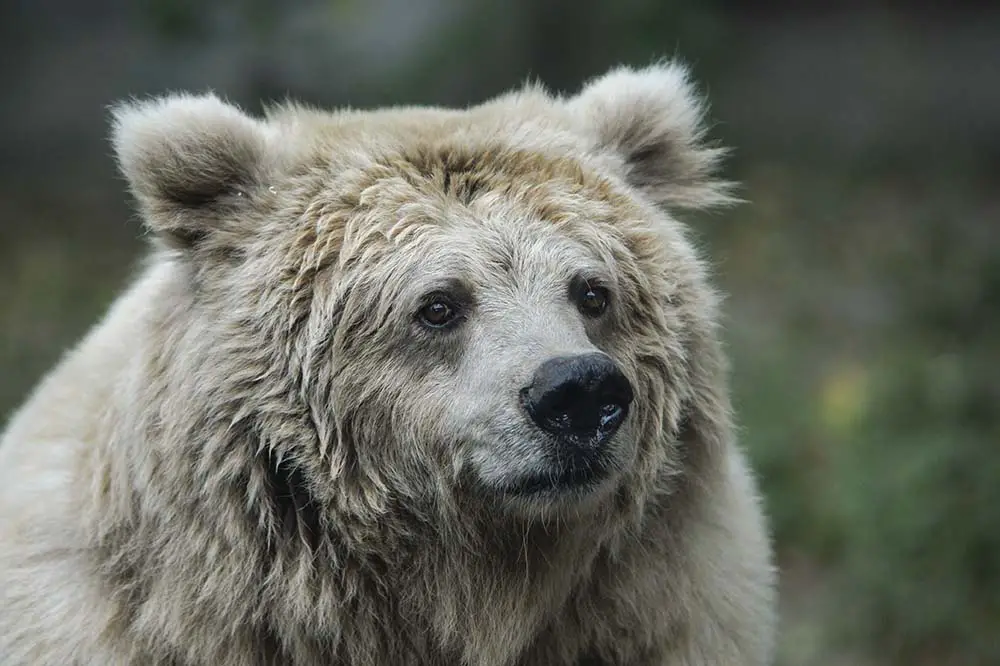
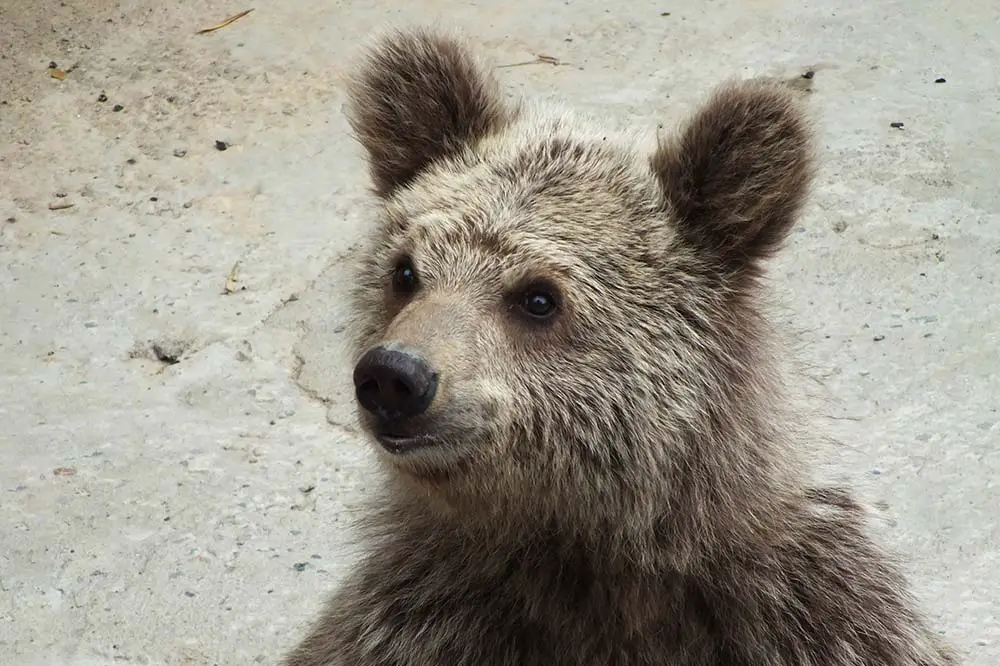
Left: Adult Himalayan brown bear | Sergei Chuzavkov / Shutterstock & Right: Himalayan brown bear cub | Artyom Ernst / Shutterstock
13 – Syrian brown bear | Ursus arctos syriacus
The Syrian brown bear is another light-coloured subspecies that have white claws, a unique trait not found in other bears. Weighing up to 550 lb (250kg), they are the smallest subspecies of brown bear, around a third the size of their Alaskan and Kamchatkan cousins. Although their range has historically included Syria, they are now extinct in the country after which they are named and are more commonly found in other parts of the Middle East and the Caucasus region. They inhabit mountainous regions that span several different types of forest including Mediterranean, deciduous and conifer forests where they search for fruits, seeds and other vegetation in addition to small mammals.
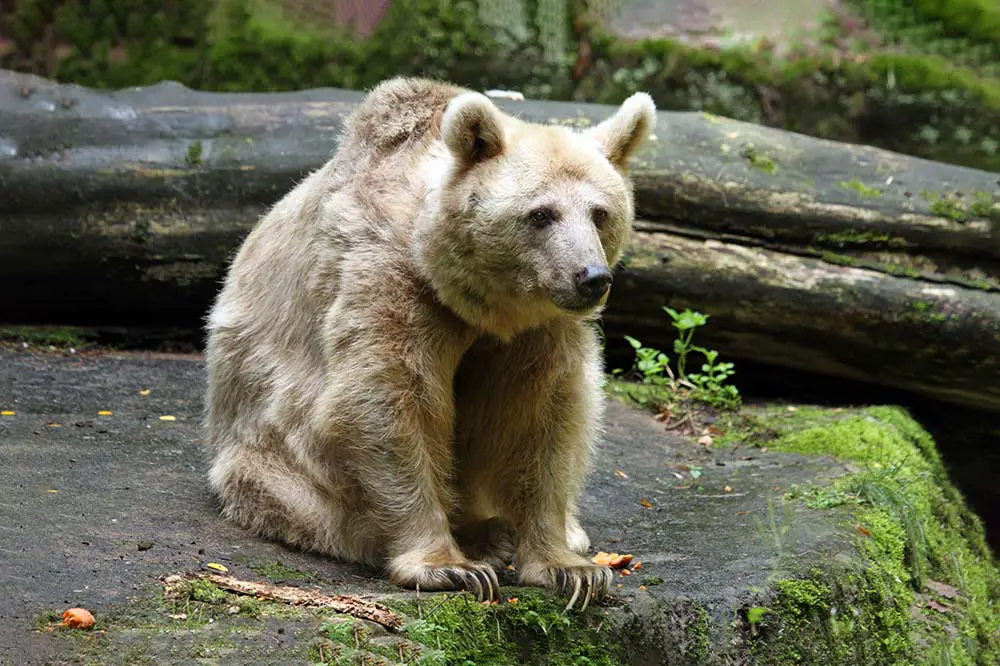
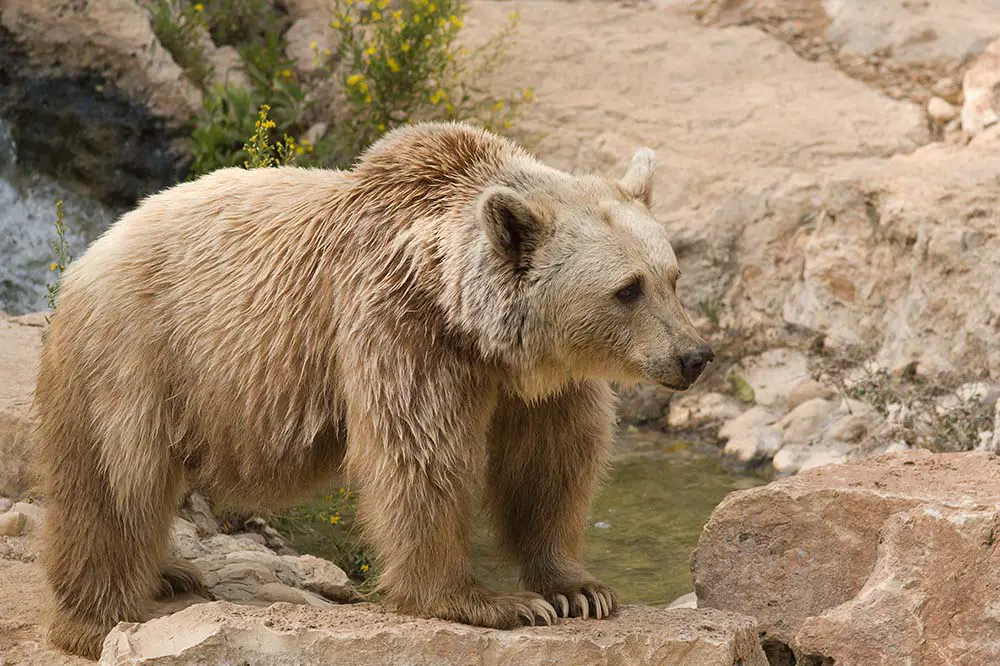
Left: Syrian brown bear | Yory Frenklakh / Shutterstock & Right: Syrian brown bear side profile | Yory Frenklakh / Shutterstock
14 – Tibetan blue bear | Ursus arctos pruinosus
The Tibetan blue bear is one of the rarest subspecies and is rarely found in the wild. They exhibit a very unique colouration and although they are mainly black and white, their guard hairs give it a greyish-blue appearance, which is particularly noticeable on its muzzle. They are found on the Tibetan plateau, which sits at the foothills of the Himalayas, the highest mountain range in the world. Their characteristics and behavioural traits are one of the least studied of all bear species but we know that they live for around 20 – 30 years in the wild and hunt many types of mammals, big and small, particularly the pika.
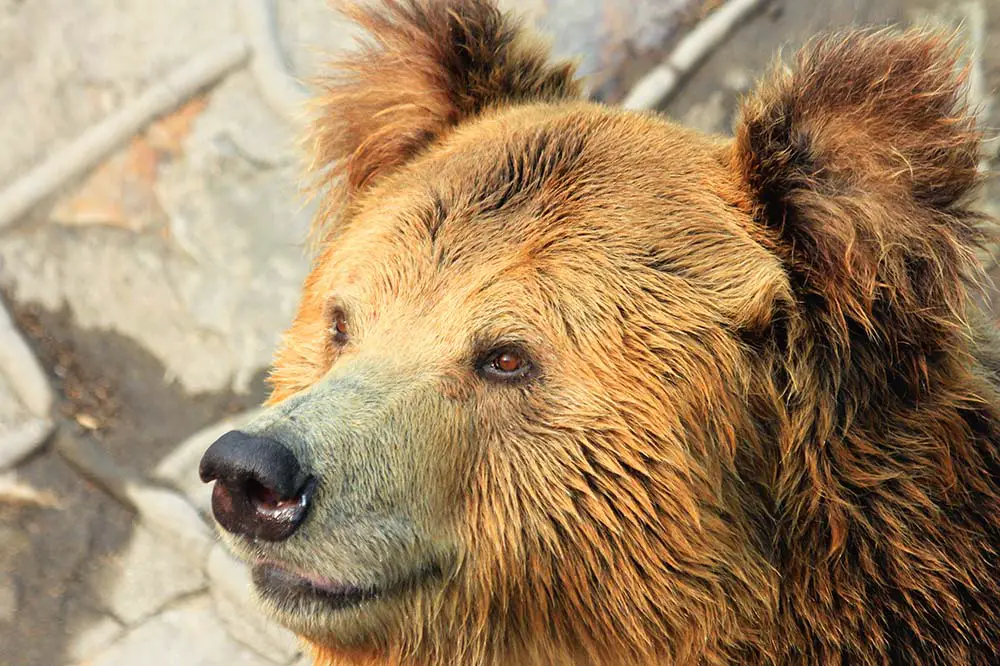
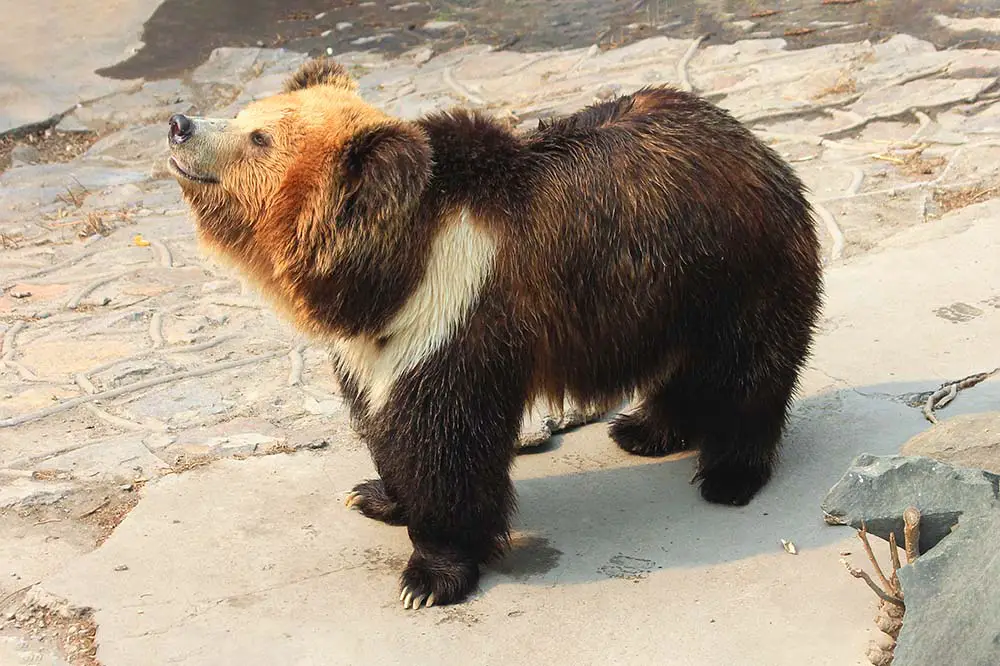
Left & Right: Tibetan blue bear | ylq / Shutterstock
15 – Polar bear | Ursus maritimus
The polar bear is the largest bear on the planet, weighing a fraction more than the largest Kodiak bears who also weigh north of 1,500lbs (750kg). Their size is largely due to their diet, which, unlike other bears who survive on a mixture of meat and vegetation, is made up almost entirely of seals. They are found solely in the arctic, the lands of which exist in Alaska, Canada, Northern Europe and Russia. Also known as the white bear, sea bear, or ice bear, their Latin name, maritimus, means of or pertaining to the sea, referencing their love of the sea ice where they spend the majority of their time. There were originally thought to be two subspecies of polar bear, one existing in North America and the other in Siberia but this has since been disproven. Polar bears usually mate in the spring, a period of time that sees males fight viciously for their mate. Females then spend the summer eating as much food as possible, often gaining over 400lbs (181kg) in preparation for hibernation. Cubs are born between November and February, often weighing just 2lbs (1kgs) and will emerge from the den in the spring weighing between 20 – 35lbs (9 – 15kg). The cubs do not leave their mother until 2 – 3 years of age and will not start breeding until the age of 5 or 6. The conservation status of the polar bear is currently set to vulnerable due largely to habitat loss caused by climate change.
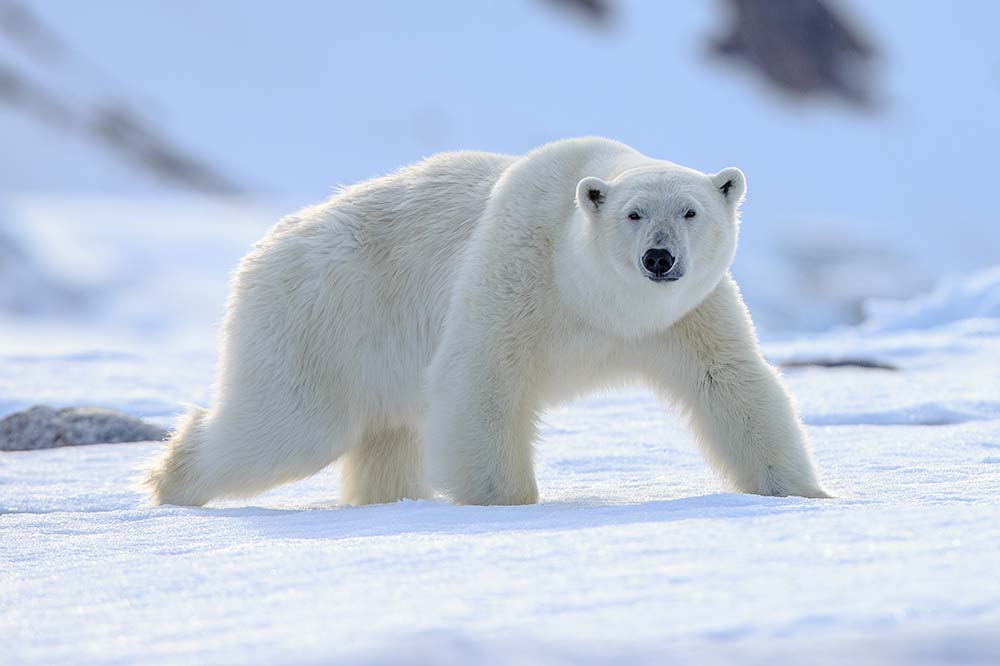
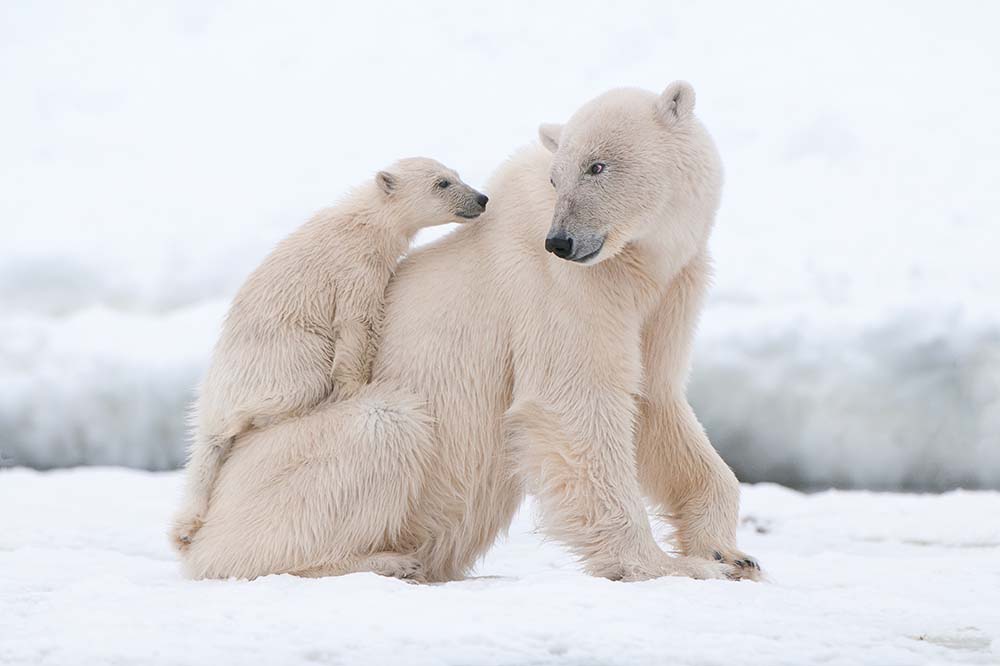
Left: Polar bear | Vaclav Sebek / Shutterstock & Right: Polar bear with cub | Gecko1968 / Shutterstock
Sources
Encyclopedia Britannica, Animal Diversity, Wikipedia, Historical range of the panda, Qinling Panda, Cloud forest, Spectacled bear and hibernation, How many sun bears are left, How many Asiatic black bears remain, The colour variations of the black bear, Dormancy and hibernation, Bears in Kamchatka, Kamchatka Brown Bears, Syrian brown bear & The Tibetan blue bear
